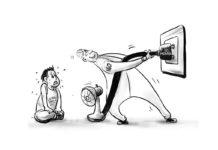BY IKE SEÑERES
DR. Gil Santos wrote: “To me it is understandable why the Philippines was not included in the countries listed by the United Nations Development Program (UNDP) because the Philippines most probably did not submit their official data. No UN agency would gather this on their own because they want the ‘official’ figures for obvious reasons – so they cannot be disowned, therefore ‘accurate’ although in almost all cases due to the government bureaucracy, a year or two at least late. This is precisely the reason why I do not rely too much on these ‘official’ figures. I go to the sources and get them. I cannot care less if they disown the figures they give me as long as I know I do not misquote or wrongly report them out of context. I want to be accurate and to never, never diminish the journalistic standards that I know and have been practicing for the past six decades.”
When I asked Dr. Santos who should be submitting the Human Development Index (HDI) data to the UNDP, he said it should be the Department of Foreign Affairs (DFA).
I agreed with him, but as far as I know, the DFA is only the collector and the aggregator of the data. As it is supposed to be, the source data has to come from some other government agency, among which is most probably the National Economic Development Authority (NEDA).
The other possible sources are the National Statistics Office (NSO) now renamed the Philippine Statistics Authority (PSA), and the National Statistical Coordination Board (NSCB).
As I understand it, the NSCB is under the NEDA, which is the reason why I believe that between the two of them, they could have easily collected and aggregated the HDI data that was supposed to be submitted to the UNDP.
Mr. Ramon Ignacio also wrote: “We have been discussing the HDI years back in our group before it was published by the Pakistani economist (Mahbub-ul Haq). This was in line with our intense disagreement with GDP/GNP measures. Our concept of human development covers economic development, personal development, political development (increased political participation and rationalization of authority) and social justice. Human development is relative to current stage of development and societal culture – thus comparison should be among similar categories.”
He added that, “Human development should take the significant roles of physical environment, social environment, political environment, economic environment and now technological environment on how they could affect human lives. The outcomes must always be related to human lives.”
Furthermore, he said that, “We cannot compare human development between Japan and the Philippines or human development between North Korea and South Korea.”
Among the three dimensions that are included in the HDI statistic (life expectancy, literacy and income), income levels or the quality of life is probably the most complicated and contentious.
Although not expressly stated, the data about income or the quality of life is directly related to the data about the poverty rate in every country. Looking at it another way, the three dimensions of the HDI statistic could simply be reported as the longevity rate, the literacy rate and the poverty rate.
Even if income levels could be a good basis for computing the poverty rate, it is not necessarily accurate. This is perhaps the reason why some economists are questioning the old approach of using the “imaginary basket of goods” approach.
This is also probably the reason why the United Nations eventually adopted the Multidimensional Poverty Index (MPI), apparently a supplement to the HDI statistic.
In theory, it is not possible for a country to have a high HDI rank if it has a high poverty rate. That is simply because if it has a high poverty rate, its income levels would probably be low, and its quality of life would probably be low also.
In reality, however, is it possible for a country to have a high poverty rate, and yet it would also have a high quality of life? If we base it on the “imaginary basket of goods” approach”, it would be possible for many people to have “access” to many of the “goods” inside the basket, if these are available to everyone in the form of public services or subsidies.
However, if we base it on the MPI approach, many people would still be considered poor if they would have no access to a dwelling with a decent Floor, some necessary appliances that could be counted as Assets, Cooking fuels, Electricity, Toilets and Safe water or FACETS (my own acronym).
Censuses are not the same as surveys, because the data in the former is supposed to be empirical, whereas the data in the latter is only supposed to be indicative.
The problem is, censuses in the Philippines are done only every five years, the last one being in 2010 and the next one is scheduled for 2015.
That is a problem, because the submission of HDI data to the UNDP is supposed to be done every year.
Besides, the data gathered in the census appears to be focused more on counting the population, rather than measuring the status of human development.
Is it possible therefore to gather the data about the status of human development on a yearly basis without waiting for the census that is done every five years?
I think that it is possible, if we gather the data from below, from the provincial level, being the only practical and credible source as I see it.
Since the Local Government Code (LGC) has already provided for the creation of the Provincial Development Councils (PDCs), I think that it is possible to mandate these councils to gather and submit the data to the NEDA, being supposedly the apex of the entire PDC structure.
Objectively, these PDCs should gather the data in the manner of censuses, and not by way of surveys. Following the principle that the data should be coming from below, these PDCs could easily collect the data from the Municipal Development Councils (MDCs), yet another layer created by the LGC.
This approach is also in line with the principle of subsidiarity; that tasks could be done better at the lowest units rather than at the very top. In terms of software programming, this is just like subdividing a problem into many manageable parts.
How could we redefine human development measurement so that it will encompass economic development, personal development, political development and social justice, at the same time considering the significant roles of the physical environment, the social environment, the political environment, the economic environment and the technological environment?
It seems that we are a long way from doing that, but the questions concerning these data sets could easily be incorporated in the annual censuses that will be conducted by the PDCs.
On the practical side, the data gathered from these censuses would give us a better understanding of how and where our taxes are being spent, by way of the General Appropriations Act and the Internal Revenue Allocations./PN



